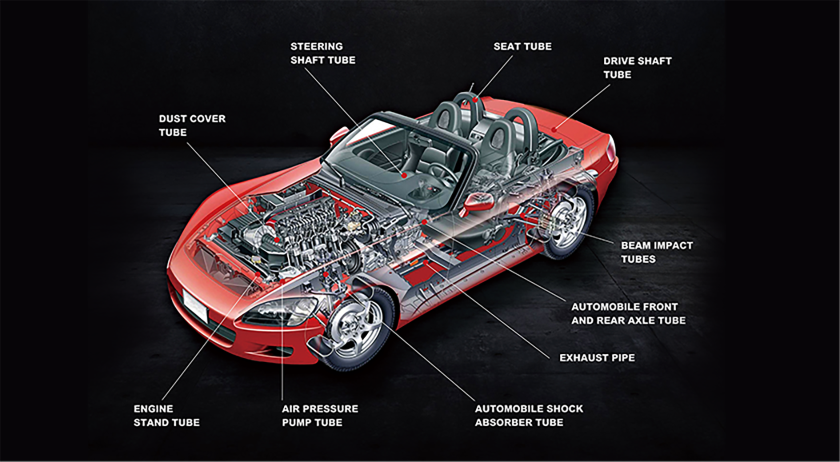Understanding Cold Formed Pipe Applications and Manufacturing Techniques
Nov . 11, 2024 01:37
Understanding Cold-Formed Pipes Advantages, Applications, and Manufacturing
Cold-formed pipes are an essential component in various industrial applications, known for their strength, precision, and versatility. This article explores the concept of cold-formed pipes, the cold-forming process, their advantages, and the industries that commonly utilize them.
What are Cold-Formed Pipes?
Cold-formed pipes are manufactured through a process in which steel or other materials are shaped at room temperature. This process enhances the material's mechanical properties without compromising its structural integrity. Unlike hot-formed pipes, which are produced by heating the metal and then reshaping it, cold-formed pipes undergo deformation at lower temperatures, leading to increased hardness and strength.
The Manufacturing Process
The production of cold-formed pipes typically involves several steps
1. Material Selection High-quality steel sheets or coils are selected based on the desired specifications and application requirements.
2. Forming The material is shaped into the desired pipe geometry using rollers or dies. This process may involve bending, twisting, and welding the sheet into a closed pipe structure.
3. Welding In many cases, a longitudinal weld is created to join the edges of the pipe, ensuring that it maintains its shape and integrity.
4. Finishing Processes Cold-formed pipes often undergo various finishing techniques, such as cutting, trimming, and surface treatment, to enhance their aesthetic appeal and corrosion resistance.
5. Quality Control Rigorous testing and inspection ensure that the finished pipes meet industry standards for strength, durability, and dimensional accuracy.
Advantages of Cold-Formed Pipes
Cold-formed pipes offer several key advantages over traditional hot-formed pipes
- Enhanced Strength The cold-working process increases the yield strength of the material, resulting in pipes that can withstand higher stress and pressure. This enhances their performance in demanding applications.
cold formed pipe
- Dimensional Accuracy Cold-forming allows for tighter tolerances and better finishes, making cold-formed pipes ideal for applications requiring precision.
- Corrosion Resistance Many cold-formed pipes are coated or treated to resist corrosion, significantly extending their lifespan in harsh environments
.
- Weight Savings Cold-formed pipes are typically lighter than their hot-formed counterparts while still providing the required strength, making them easier to handle and install.
- Cost-effectiveness The efficient production methods used in cold forming often result in lower material waste and reduced manufacturing costs.
Applications of Cold-Formed Pipes
Cold-formed pipes are widely used across various industries, including
- Construction In the construction sector, cold-formed pipes serve as structural components, such as columns, beams, and braces in buildings and bridges.
- Automotive The automotive industry utilizes cold-formed pipes for exhaust systems, chassis, and other structural elements due to their strength and lightweight characteristics.
- Oil and Gas In oil and gas exploration, cold-formed pipes are used in casing, tubing, and various piping systems due to their durability and ability to withstand high pressures.
- Manufacturing Cold-formed pipes are commonly found in manufacturing equipment, HVAC systems, and machinery, where precision and reliability are critical.
- Consumer Products Various consumer goods, such as furniture and household appliances, often incorporate cold-formed pipes for their strength and aesthetic appeal.
Conclusion
Cold-formed pipes represent a vital innovation in pipe manufacturing, combining strength, precision, and versatility. Their unique properties make them indispensable in many applications across diverse industries. As manufacturing technologies continue to advance, the future of cold-formed pipes looks promising, with ongoing research focused on enhancing their capabilities and expanding their applications. Understanding the benefits and uses of cold-formed pipes is essential for professionals in engineering, construction, and manufacturing sectors, as these pipes play a crucial role in building the infrastructure of tomorrow.
 Afrikaans
Afrikaans  Albanian
Albanian  Amharic
Amharic  Arabic
Arabic  Armenian
Armenian  Azerbaijani
Azerbaijani  Basque
Basque  Belarusian
Belarusian  Bengali
Bengali  Bosnian
Bosnian  Bulgarian
Bulgarian  Catalan
Catalan  Cebuano
Cebuano  Corsican
Corsican  Croatian
Croatian  Czech
Czech  Danish
Danish  Dutch
Dutch  English
English  Esperanto
Esperanto  Estonian
Estonian  Finnish
Finnish  French
French  Frisian
Frisian  Galician
Galician  Georgian
Georgian  German
German  Greek
Greek  Gujarati
Gujarati  Haitian Creole
Haitian Creole  hausa
hausa  hawaiian
hawaiian  Hebrew
Hebrew  Hindi
Hindi  Miao
Miao  Hungarian
Hungarian  Icelandic
Icelandic  igbo
igbo  Indonesian
Indonesian  irish
irish  Italian
Italian  Japanese
Japanese  Javanese
Javanese  Kannada
Kannada  kazakh
kazakh  Khmer
Khmer  Rwandese
Rwandese  Korean
Korean  Kurdish
Kurdish  Kyrgyz
Kyrgyz  Lao
Lao  Latin
Latin  Latvian
Latvian  Lithuanian
Lithuanian  Luxembourgish
Luxembourgish  Macedonian
Macedonian  Malgashi
Malgashi  Malay
Malay  Malayalam
Malayalam  Maltese
Maltese  Maori
Maori  Marathi
Marathi  Mongolian
Mongolian  Myanmar
Myanmar  Nepali
Nepali  Norwegian
Norwegian  Norwegian
Norwegian  Occitan
Occitan  Pashto
Pashto  Persian
Persian  Polish
Polish  Portuguese
Portuguese  Punjabi
Punjabi  Romanian
Romanian  Samoan
Samoan  Scottish Gaelic
Scottish Gaelic  Serbian
Serbian  Sesotho
Sesotho  Shona
Shona  Sindhi
Sindhi  Sinhala
Sinhala  Slovak
Slovak  Slovenian
Slovenian  Somali
Somali  Spanish
Spanish  Sundanese
Sundanese  Swahili
Swahili  Swedish
Swedish  Tagalog
Tagalog  Tajik
Tajik  Tamil
Tamil  Tatar
Tatar  Telugu
Telugu  Thai
Thai  Turkish
Turkish  Turkmen
Turkmen  Ukrainian
Ukrainian  Urdu
Urdu  Uighur
Uighur  Uzbek
Uzbek  Vietnamese
Vietnamese  Welsh
Welsh  Bantu
Bantu  Yiddish
Yiddish  Yoruba
Yoruba  Zulu
Zulu 












